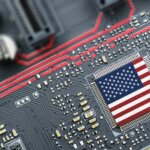The US continues to be concern on how China is growing its semiconductor industry. (Image – Shutterstock)
As China’s semiconductor industry grows, concerns mount in the US
|
Getting your Trinity Audio player ready... |
- China’s semiconductor industry growth is a concern for the US
- Department of Defense and Department of Commerce sign MoU on chip development for defense.
- The US is also concern on China’s use of legacy chips.
As the semiconductor industry in China continues to grow and become self-sufficient, there is mounting concern in the US. Specifically, the Department of Commerce and Defense in the US is worried about how China’s semiconductor industry growth could impact national security.
Both departments have signed a memorandum to extend collaboration to strengthen the US semiconductor defense industrial bases. To be precise, both departments will increase information sharing to facilitate the coordination of the CHIPS for America’s incentives program. This is also to ensure that respective investments position the US to produce semiconductor chips that are essential for national security and defense programs.
According to a press statement, Dr. Laura Taylor-Kale, Assistant Secretary of Defense for Industrial Base Policy said the agreement is an important step forward in increasing the capacity and resiliency of the domestic semiconductor industry base.
“It is essential for the Department of Defense (DoD) and Department of Commerce (DoC) to consult one another to ensure we are making complementary investments that support a robust semiconductor industrial base. Both Departments are working together to expand domestic semiconductor production capacity in a coordinated fashion,” said Dr Taylor-Kale.
For CHIPS Program Office Director Michael Schmidt, the agreement will enable teams to coordinate the national security review of applications, produce semiconductor chips in America that the military relies on, and bolster domestic supply chain resiliency.
Chips for America is part of President Biden’s economic plan to grow investment in the semiconductor industry in the US. A total of US$ 52 billion has been allocated to the plans, which also include stimulating private sector investment, the creation of good-paying jobs, and the revitalization of marginalized communities.

Fab equipment spending continues to increase. (Image – Shutterstock)
The state of the global semiconductor industry
The global semiconductor industry faces heavy competition as the US continues to control China’s semiconductor supply chain. China, which is one of the world’s largest semiconductor producers has already had several sanctions on chip imports. However, the semiconductor industry in the country has been working on alternatives within the country to ensure that production continues and that a global supply chain shortage of semiconductors is avoided.
In fact, according to a report by SCMP, sales of semiconductor equipment to China dropped 23% year on year in the first quarter of 2023 amid US export curbs, according to SEMI data. Interestingly, the US and the rest of North America bought 50% more semiconductor equipment during that period.
SEMI, which monitors global semiconductor manufacturing also highlights in its March report that while China is forecast to place third in equipment spending worldwide in 2024, U.S. export controls are expected to limit the region’s spending to US$16 billion, comparable to the region’s investments in 2023.
In 2024, the US is expected to remain the fourth largest region in spending with a record US$11 billion in investments. Meanwhile, Europe and the Middle East are also forecast to log record investments next year, increasing spending by 36% to US$8.2 billion. In Japan and Southeast Asia, fab equipment is expected to increase to US$7.0 billion and US$3.0 billion, respectively, in 2024.
According to a report by Reuters, US Commerce Secretary Gina Raimondo said the Biden administration is seeking to carefully target U.S. controls on exports to China, but rules will cost firms some revenue. The report quoted Raimondo saying “that you deny American companies revenue and China can get the product elsewhere, or China can get the product from other countries.” Raimondo added that rules “will deny some revenue to American companies, but we think it’s worth it.”
US Commerce Secretary Gina Raimondo said the Biden administration is seeking to carefully target U.S. controls on exports to China.
China’s semiconductor industry turning to legacy chips
Meanwhile, the semiconductor industry in China is working round the clock to find solutions to the bans being imposed on them. A report by Bloomberg interestingly highlighted that US and European officials are now growing increasingly concerned about China’s accelerated push into the production of older-generation semiconductors. The concerns have led to officials debating new strategies to contain the country’s expansion.
The report also stated that officials are worried that Chinese semiconductor companies would dump these legacy chips on the global markets in the future. They feel that Western companies may then have no choice but to be dependent on China for semiconductors.
For the Chinese semiconductor industry, apart from the global supply chain disruptions due to the COVID-19 pandemic, no matter how many bans are implemented, they continue to find a way to avoid disruption and continue with their chip production. What makes it more interesting is many countries are still doing business with them, which is why the US feels that they need to be more prepared to deal with any potential national security issues.
As such, it only makes more sense why the DoD and DoC are working together in chip development in the semiconductor industry in the US. The end game is to ensure that the chips are not only made in the US but also go through a national security review and are used by the defense industry.
READ MORE
- Safer Automation: How Sophic and Firmus Succeeded in Malaysia with MDEC’s Support
- Privilege granted, not gained: Intelligent authorization for enhanced infrastructure productivity
- Low-Code produces the Proof-of-Possibilities
- New Wearables Enable Staff to Work Faster and Safer
- Experts weigh in on Oracle’s departure from adland


